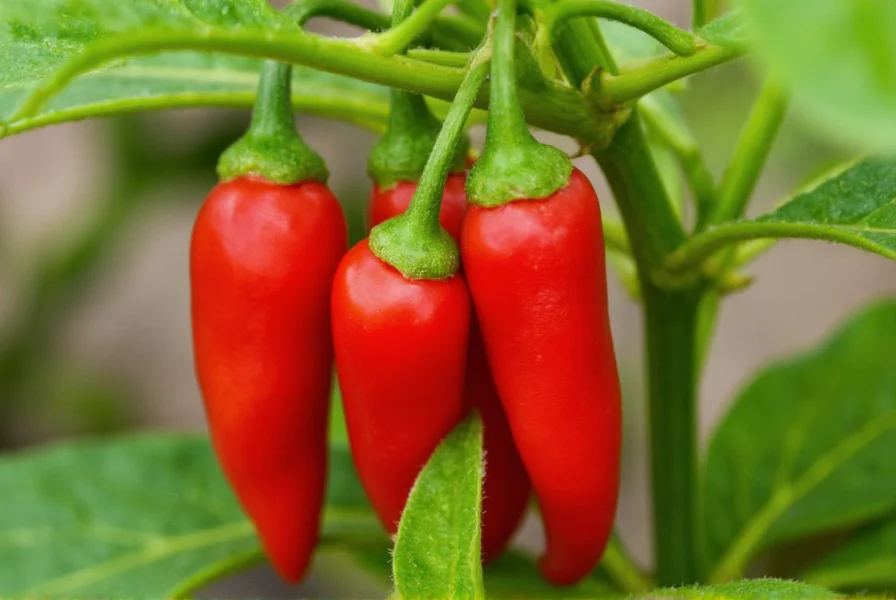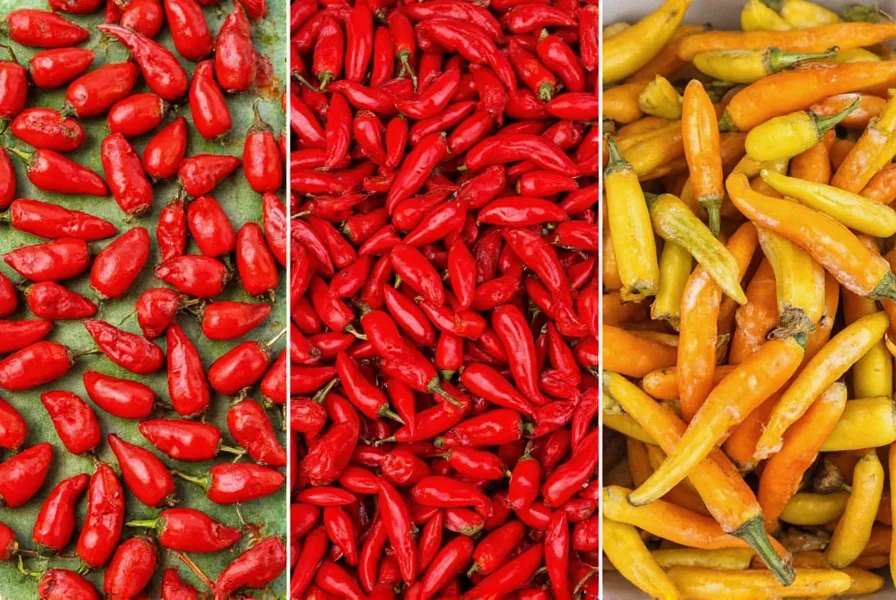The sriracha pepper, scientifically known as Capsicum annuum, is a vibrant red chili pepper measuring 10,000-22,800 Scoville Heat Units (SHU). Unlike the popular Huy Fong sriracha sauce which uses red jalapeños, authentic sriracha peppers are thinner, brighter red, and slightly hotter than standard jalapeños. These versatile peppers originated in Si Racha, Thailand, and feature a distinctive garlicky flavor with moderate heat that makes them ideal for sauces, marinades, and fresh culinary applications.
The sriracha pepper has become increasingly popular among home cooks and professional chefs alike, yet many confuse it with the ubiquitous sriracha sauce. Understanding the actual pepper behind the famous condiment reveals a world of culinary possibilities beyond the iconic rooster bottle. This comprehensive guide explores everything you need to know about the genuine sriracha pepper, from its botanical characteristics to practical growing and cooking applications.
Botanical Profile and Physical Characteristics
Sriracha peppers typically measure 2-3 inches in length with a slender, tapered shape that distinguishes them from the plumper jalapeño. They mature from green to a brilliant red color and feature smooth, glossy skin. The plant grows to approximately 24-30 inches tall and produces abundant fruit throughout the growing season.
| Characteristic | Sriracha Pepper | Jalapeño Pepper | Cayenne Pepper |
|---|---|---|---|
| Scoville Heat Units | 10,000-22,800 SHU | 2,500-8,000 SHU | 30,000-50,000 SHU |
| Length | 2-3 inches | 2-3.5 inches | 6-8 inches |
| Shape | Slender, tapered | Thick, cylindrical | Long, thin |
| Flavor Profile | Garlicky, bright, moderate heat | Grassy, vegetal | Sharp, intense heat |
Origin and History
Despite the global popularity of sriracha sauce, the actual sriracha pepper originates from Si Racha, a coastal city in Chonburi Province, Thailand. The region's climate proved ideal for cultivating this particular chili variety, which became a staple in Thai cuisine long before the sauce gained international fame. Traditional Thai cooks have used fresh sriracha peppers in seafood dishes, dipping sauces, and stir-fries for generations.
The confusion between the pepper and the sauce stems from David Tran's Huy Fong Foods, which created the now-famous sriracha sauce using red jalapeños rather than authentic sriracha peppers. This commercial adaptation, while delicious, has led to widespread misunderstanding about the actual pepper variety.
Culinary Applications of Fresh Sriracha Peppers
When working with fresh sriracha peppers, their unique flavor profile opens numerous culinary possibilities:
- Sauces and condiments: Create authentic Thai-style dipping sauces by blending fresh sriracha peppers with garlic, vinegar, sugar, and fish sauce
- Marinades: The moderate heat penetrates proteins beautifully without overwhelming other flavors
- Stir-fries: Add sliced peppers during the final minutes of cooking to preserve their bright flavor
- Pickling: Their firm texture holds up well to pickling processes
- Salsas: Combine with tomatoes, onions, and cilantro for a vibrant, moderately spicy salsa
Professional chefs particularly value sriracha peppers for their balanced heat-to-flavor ratio. Unlike some hotter varieties where the heat dominates, sriracha peppers deliver noticeable warmth while allowing their distinctive garlicky notes to shine through—a characteristic that makes them exceptionally versatile in sriracha pepper culinary uses.
Growing Sriracha Peppers at Home
For gardeners interested in how to grow sriracha peppers, these plants offer a rewarding experience. They thrive in warm climates with full sun exposure and well-draining soil. Start seeds indoors 8-10 weeks before the last frost date, maintaining soil temperatures around 80-85°F for optimal germination.
Once established, sriracha pepper plants require consistent watering (without waterlogging) and benefit from balanced fertilizer applications every 3-4 weeks. The plants typically begin producing fruit 70-80 days after transplanting outdoors. For best results when considering sriracha pepper plant care, pinch off the first few flowers to encourage stronger plant development before fruiting.

Sriracha Pepper Substitutes and Comparisons
When authentic sriracha peppers aren't available, understanding sriracha pepper vs jalapeno differences helps identify suitable alternatives. While jalapeños are the primary ingredient in commercial sriracha sauce, they're actually milder and lack the distinctive garlicky notes of true sriracha peppers.
Better substitutes include:
- Serrano peppers: Similar heat level with bright flavor (though slightly hotter)
- Fresno peppers: Comparable heat with similar fruity notes
- Thai bird chilies: Much hotter, so use sparingly as substitute
- Red jalapeños: The closest commercially available option, though milder
For those searching where to buy sriracha peppers, check Asian grocery stores, farmers' markets during peak season, or specialty seed catalogs for plants. Some online retailers also ship fresh peppers during harvest season.
Nutritional Benefits
Sriracha peppers, like other chili varieties, contain capsaicin—the compound responsible for their heat—which has been studied for potential metabolic and anti-inflammatory benefits. They're also rich in:
- Vitamin C (more than citrus fruits by weight)
- Vitamin A (from beta-carotene)
- Vitamin B6
- Potassium
- Dietary fiber
These nutritional properties make sriracha peppers a valuable addition to fresh sriracha pepper recipes designed to maximize health benefits while delivering flavorful heat.
Storage and Preservation Techniques
To extend the shelf life of your sriracha peppers, consider these storage methods:
- Refrigeration: Store unwashed peppers in a paper bag in the crisper drawer for 2-3 weeks
- Freezing: Freeze whole or sliced peppers in airtight containers for up to 6 months
- Drying: String peppers and air-dry, or use a food dehydrator for long-term storage
- Pickling: Preserves flavor while adding tangy dimension
- Oil preservation: Submerge in olive oil with garlic for flavored oil and preserved peppers

Common Questions About Sriracha Peppers
Are sriracha peppers the same as the peppers used in sriracha sauce?
No, authentic sriracha peppers differ from the peppers used in commercial sriracha sauce. The popular Huy Fong sriracha sauce actually uses red jalapeños, not true sriracha peppers. Authentic sriracha peppers are slightly thinner, brighter red, and have a more pronounced garlicky flavor with moderate heat compared to standard jalapeños.
How hot are sriracha peppers compared to other common chili varieties?
Sriracha peppers measure between 10,000-22,800 Scoville Heat Units (SHU), making them noticeably hotter than jalapeños (2,500-8,000 SHU) but milder than cayenne peppers (30,000-50,000 SHU). Their heat is balanced by a distinctive garlicky flavor that makes them more versatile in cooking than many other medium-heat peppers.
Can I grow sriracha peppers in containers?
Yes, sriracha peppers grow well in containers. Choose a pot at least 12 inches in diameter with good drainage. Use quality potting mix rather than garden soil, and place the container in a location receiving 6-8 hours of direct sunlight daily. Container-grown plants will need more frequent watering and regular feeding with balanced fertilizer compared to in-ground plants.
What's the best way to handle sriracha peppers without burning my skin?
Always wear gloves when handling sriracha peppers, especially when cutting or seeding them. The capsaicin oils can transfer to your skin and cause irritation, particularly if you touch your eyes or face. After handling, wash your hands thoroughly with soap and warm water—even if you wore gloves. Avoid using alcohol-based hand sanitizers immediately after handling hot peppers, as this can spread the capsaicin oils.
How can I reduce the heat of sriracha peppers in my cooking?
To reduce heat while preserving flavor, remove the white pith and seeds where most capsaicin is concentrated. Cooking the peppers can also mellow their heat—try sautéing them gently in oil before adding to dishes. Pairing with dairy products like yogurt or sour cream, or acidic ingredients like lime juice, can help balance the heat. For sriracha pepper substitute options with less heat, consider using fewer peppers or substituting with milder varieties like poblanos.











 浙公网安备
33010002000092号
浙公网安备
33010002000092号 浙B2-20120091-4
浙B2-20120091-4